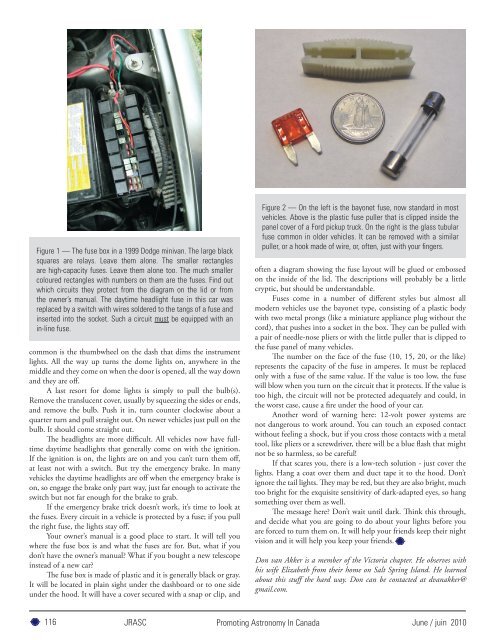I N S I D E T H I S I S S U E
insidethisissue - The Royal Astronomical Society of Canada
insidethisissue - The Royal Astronomical Society of Canada
- No tags were found...
You also want an ePaper? Increase the reach of your titles
YUMPU automatically turns print PDFs into web optimized ePapers that Google loves.
Figure 1 — The fuse box in a 1999 Dodge minivan. The large blacksquares are relays. Leave them alone. The smaller rectanglesare high-capacity fuses. Leave them alone too. The much smallercoloured rectangles with numbers on them are the fuses. Find outwhich circuits they protect from the diagram on the lid or fromthe owner’s manual. The daytime headlight fuse in this car wasreplaced by a switch with wires soldered to the tangs of a fuse andinserted into the socket. Such a circuit must be equipped with anin-line fuse.common is the thumbwheel on the dash that dims the instrumentlights. All the way up turns the dome lights on, anywhere in themiddle and they come on when the door is opened, all the way downand they are off.A last resort for dome lights is simply to pull the bulb(s).Remove the translucent cover, usually by squeezing the sides or ends,and remove the bulb. Push it in, turn counter clockwise about aquarter turn and pull straight out. On newer vehicles just pull on thebulb. It should come straight out.The headlights are more difficult. All vehicles now have fulltimedaytime headlights that generally come on with the ignition.If the ignition is on, the lights are on and you can’t turn them off,at least not with a switch. But try the emergency brake. In manyvehicles the daytime headlights are off when the emergency brake ison, so engage the brake only part way, just far enough to activate theswitch but not far enough for the brake to grab.If the emergency brake trick doesn’t work, it’s time to look atthe fuses. Every circuit in a vehicle is protected by a fuse; if you pullthe right fuse, the lights stay off.Your owner’s manual is a good place to start. It will tell youwhere the fuse box is and what the fuses are for. But, what if youdon’t have the owner’s manual? What if you bought a new telescopeinstead of a new car?The fuse box is made of plastic and it is generally black or gray.It will be located in plain sight under the dashboard or to one sideunder the hood. It will have a cover secured with a snap or clip, andFigure 2 — On the left is the bayonet fuse, now standard in mostvehicles. Above is the plastic fuse puller that is clipped inside thepanel cover of a Ford pickup truck. On the right is the glass tubularfuse common in older vehicles. It can be removed with a similarpuller, or a hook made of wire, or, often, just with your fingers.often a diagram showing the fuse layout will be glued or embossedon the inside of the lid. The descriptions will probably be a littlecryptic, but should be understandable.Fuses come in a number of different styles but almost allmodern vehicles use the bayonet type, consisting of a plastic bodywith two metal prongs (like a miniature appliance plug without thecord), that pushes into a socket in the box. They can be pulled witha pair of needle-nose pliers or with the little puller that is clipped tothe fuse panel of many vehicles.The number on the face of the fuse (10, 15, 20, or the like)represents the capacity of the fuse in amperes. It must be replacedonly with a fuse of the same value. If the value is too low, the fusewill blow when you turn on the circuit that it protects. If the value istoo high, the circuit will not be protected adequately and could, inthe worst case, cause a fire under the hood of your car.Another word of warning here: 12-volt power systems arenot dangerous to work around. You can touch an exposed contactwithout feeling a shock, but if you cross those contacts with a metaltool, like pliers or a screwdriver, there will be a blue flash that mightnot be so harmless, so be careful!If that scares you, there is a low-tech solution - just cover thelights. Hang a coat over them and duct tape it to the hood. Don’tignore the tail lights. They may be red, but they are also bright, muchtoo bright for the exquisite sensitivity of dark-adapted eyes, so hangsomething over them as well.The message here? Don’t wait until dark. Think this through,and decide what you are going to do about your lights before youare forced to turn them on. It will help your friends keep their nightvision and it will help you keep your friends.Don van Akker is a member of the Victoria chapter. He observes withhis wife Elizabeth from their home on Salt Spring Island. He learnedabout this stuff the hard way. Don can be contacted at dvanakker@gmail.com.116 JRASC June / juin 2010Promoting Astronomy In Canada
















